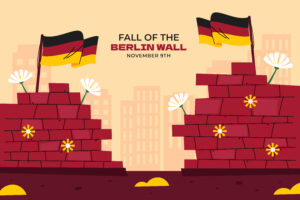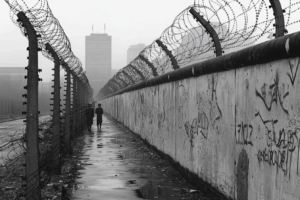
Introduction: The Night That Changed Everything
On November 9, 1989, a bureaucratic error sparked chaos at the Berlin Wall. East German officials mistakenly announced immediate border openings, and within hours, thousands flooded checkpoints with sledgehammers and champagne. The 28-mile concrete barrier—once a deadly symbol of Cold War division—was now a relic.
But the Wall’s fall wasn’t just a German story. It triggered NATO expansion, EU integration, and even Putin’s obsession with “lost” Soviet territory. Let’s dissect how 1989’s dominoes still tilt modern geopolitics.
Why the Berlin Wall Was Built: A Cold War Flashpoint
After WWII, Germany split into four occupation zones. By 1961, 3.5 million East Germans had fled to the West via Berlin, crippling the Soviet-backed economy. The Wall was Moscow’s brute-force solution:
-
“Anti-Fascist Protection Rampart”: East Germany’s propaganda name for the Wall, which included guard towers, floodlights, and a “death strip” of landmines.
-
Escapes & Tragedies: At least 140 people died attempting to cross. One famous 1979 escape involved a hot-air balloon made from scrap fabric.
Fun Fact: The Wall was actually two walls with a no-man’s-land between them—a physical manifestation of Iron Curtain ideology.

1989: The Year the Wall Cracked
The Wall didn’t collapse overnight. A perfect storm of events led to its demise:
-
Gorbachev’s Reforms: Soviet leader Mikhail Gorbachev’s glasnost (openness) policy loosened Moscow’s grip on Eastern Europe.
-
Leipzig Protests: Weekly “Monday Demonstrations” saw 300,000 East Germans demand democracy by October 1989.
-
The Press Conference Blunder: On November 9, East German official Günter Schabowski incorrectly stated new travel rules were effective “immediately,” sparking mass border crossings.
Then vs. Now:
-
1989: East Berlin average rent: 30 East Marks/month ($5 USD).
-
2024: Berlin rent: €1,200/month ($1,300 USD)—a 26,000% increase adjusted for inflation.
How the Fall Redrew Europe’s Map
The Wall’s collapse accelerated seismic shifts:
-
German Reunification (1990): East Germany dissolved, merging into the Federal Republic. The process cost $2 trillion but birthed Europe’s largest economy.
-
EU Expansion: Former Eastern Bloc nations like Poland and Hungary joined the EU by 2004, shifting power westward.
-
NATO’s March East: Russia’s resentment over NATO absorbing ex-Warsaw Pact states fuels tensions today.
How did 1990s globalization change culture? Explore Time Genius’s 1990s decade breakdown.
The Wall’s Shadow in Modern Politics
From Brexit to Ukraine, 1989’s echoes persist:
-
Putin’s Nostalgia: The Russian leader called the USSR’s collapse “the greatest geopolitical catastrophe” of the 20th century.
-
Rise of Far-Right Populism: Former East German states now vote heavily for the anti-immigrant AfD party, a backlash to rapid reunification.
Expert Insight: Historian Anne Applebaum notes that Eastern Europe’s post-1989 corruption stems from rushed privatizations—a cautionary tale for developing nations.

What If the Wall Had Survived?
Speculative history reveals stark alternatives:
-
No Eurozone: A divided Germany might’ve rejected the euro, fracturing EU monetary policy.
-
Delayed Digital Revolution: East Germany’s Stasi surveillance state could’ve evolved into a China-style firewall.
Conclusion: Why 1989 Still Matters
The Berlin Wall’s fall taught us that borders are human inventions—and just as breakable. For younger generations, it’s a reminder that today’s divisions (Brexit, Taiwan Strait) may seem permanent but aren’t.
1989 vs. Today: A Snapshot
| Metric | 1989 | 2024 |
|---|---|---|
| Cost of a VW Golf | $10,000 (West Germany) | $28,000 (Germany) |
| Avg. East German Salary | 1,100 East Marks/yr ($183) | €44,000/yr ($48,000) |
| Geopolitical Threat | USSR | Russia-Ukraine War |
For deeper dives, check out The Collapse: The Accidental Opening of the Berlin Wall on Amazon.
Affiliate Disclaimer: Time Genius participates in affiliate marketing programs. This means we may earn commissions on qualifying purchases made through our carefully selected links, at no extra cost to you. These partnerships help support our research and content creation.


